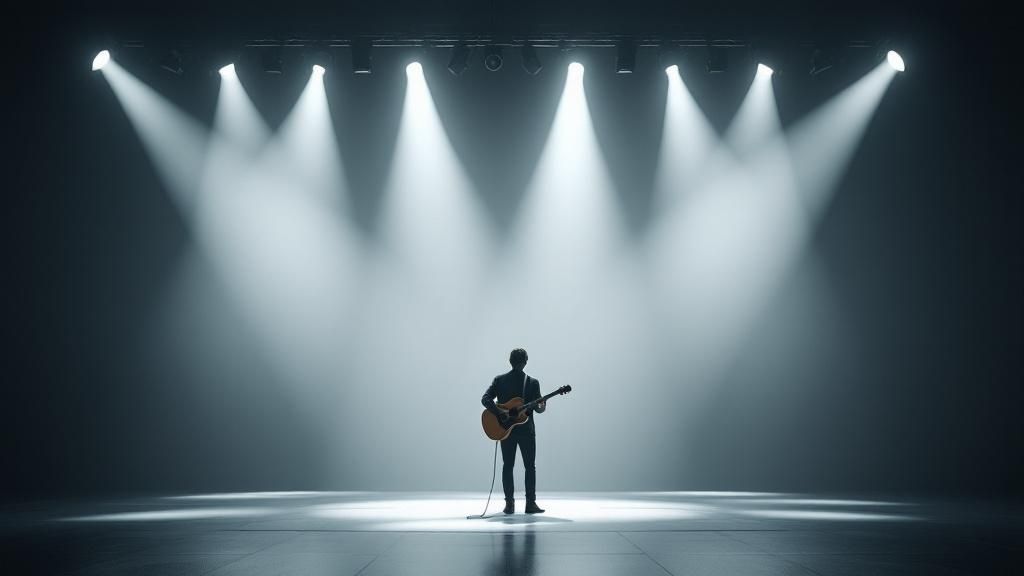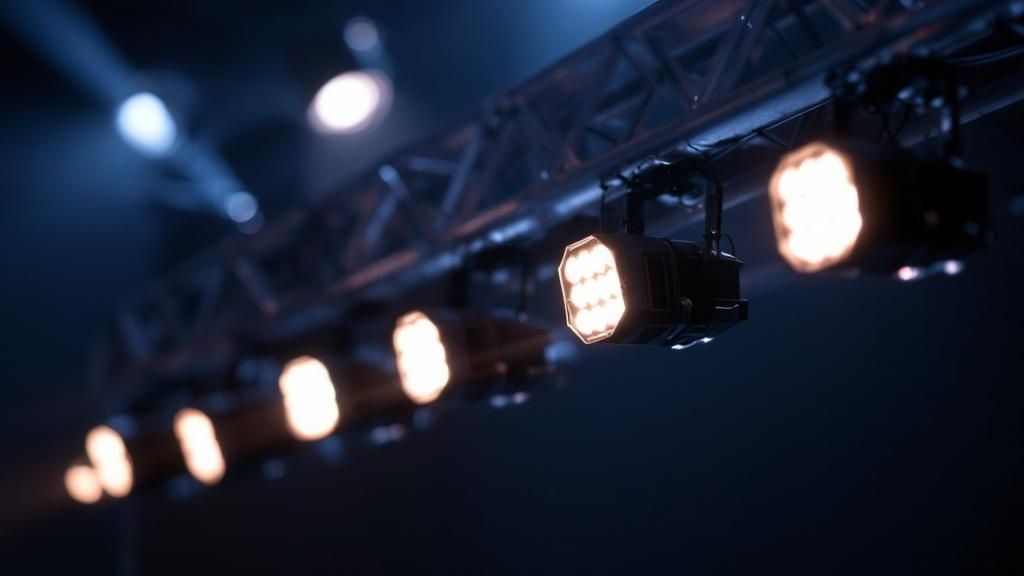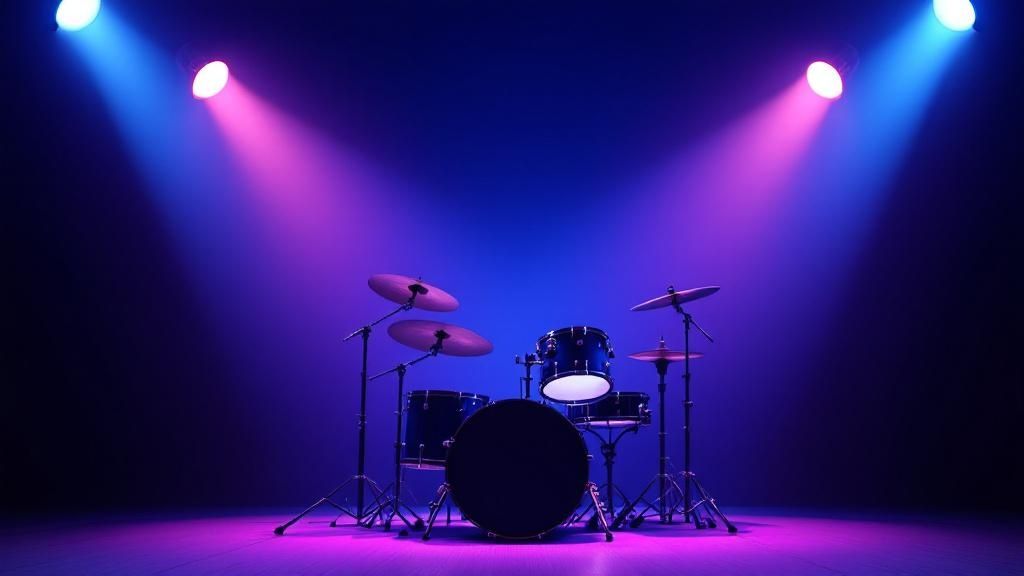Stage Lighting for Bands: Boost Your Live Show Impressiveness
- Chase Gillmore

- Jun 23
- 15 min read
How Stage Lighting for Bands Evolved Into Concert Magic

The first massive change came with the arrival of electricity, which truly set the stage for modern live entertainment. The incandescent lamp was a complete game-changer. For the first time, venues could be lit brightly and safely, without the need for open flames. This wasn't just about reducing risk; it was about gaining control. The Paris Opera embraced this new technology in 1880, with London's Savoy Theatre following suit in 1881, forever altering theatrical productions. This moment signaled the end of the gaslight era and the beginning of electric stage design, laying the groundwork for every concert that would follow.
From Static to Dynamic: The Rock and Roll Revolution
As music got louder and more expressive, so did the need for lighting that could keep up. The fixed, functional lights of old theaters just couldn't match the raw energy of rock and roll. During the 1960s and 70s, artists and forward-thinking lighting designers started to experiment, treating light as another member of the band. They used colored gels, basic spotlights, and even repurposed aircraft landing lights to create powerful effects that reflected the music’s intensity.
This was the period when lighting started to help tell the story, building tension during a guitar solo or creating a close, personal mood for a slow song. Famous venues like The Fillmore became testing grounds for these new techniques, writing the playbook for the modern concert experience. The focus was no longer just on seeing the band, but on feeling the show on a much deeper level.
The Modern Era: Where Technology Meets Artistry
Today, the evolution of stage lighting is moving faster than ever. The development of intelligent lighting fixtures—like moving heads and scanners—and the switch to highly adaptable LED technology have given bands an amazing amount of creative freedom. A single light can now shift its color, shape, and position in a fraction of a second, all perfectly timed with the music. For a top-tier group like [Uptown Drive](https://www.uptowndrive.com/), this technology is crucial for delivering the energetic, polished shows that make them one of the most popular wedding bands in Texas. Their talent for creating a custom visual atmosphere for each part of an event—from a soft, romantic first dance to an all-out party—is a perfect example of how far stage lighting has come.
This power to direct the visual experience is what separates professional bands from the rest. It's a detail that turns a great party into an unforgettable one and is a key thing to think about when you're planning an event. In fact, checking a band’s technical skills is just as vital as looking at their song list, which we discuss in our guide on [7 questions to ask your live wedding band before booking](https://www.uptowndrive.com/post/7-questions-to-ask-your-live-wedding-band-before-booking). From candlelight to choreographed LEDs, the mission has changed from simple sight to pure spectacle.
Decoding the Modern Stage Lighting System for Bands

Think of a modern stage lighting system as a band's visual orchestra. Each piece plays a specific part, and when they work together, the result is a stunning performance that connects with the audience on a deeper level. It’s not just about making the stage brighter; it’s a coordinated system where lights, controllers, and supports combine to create an unforgettable show. The best stage lighting for bands is never a random assortment of gear, but a complete setup built to amplify the music's emotion.
At the core of any rig are the lighting fixtures themselves. These are the "instruments" that paint the stage with light. They range from static PAR cans that wash the stage in color to intelligent moving head lights that can pan, tilt, and project complex patterns known as gobos. A good lighting rig needs a mix of fixtures—just like a band needs both a solid rhythm section and a soaring lead guitar—to build scenes with depth, texture, and focus.
The Brains Behind the Brilliance: Control Systems
If fixtures are the instruments, the lighting controller is the conductor. It's the brain of the operation, telling every light exactly what to do and when to do it. These controllers can be anything from a simple board with faders to advanced software that syncs light changes perfectly with a song's beat. Professional bands like [Uptown Drive](https://www.uptowndrive.com/), known for their high-energy shows at corporate events across Texas, depend on these advanced systems. This allows them to pre-program entire shows, ensuring a dramatic lighting cue hits at the exact moment a song reaches its climax.
This level of control is what separates a polished, professional look from an amateur one. It enables a lighting designer to create slow, subtle fades during a ballad and then switch to fast, high-energy strobes for a dance track, all with perfect timing. Without a capable controller, even the most expensive lights are stuck doing basic, uninspired effects.
Power and Structure: The Unseen Foundation
The two most overlooked yet vital parts of any lighting system are power distribution and structural support. A professional rig draws a lot of electricity. Plugging dozens of high-powered lights into standard wall outlets is a recipe for disaster, risking tripped breakers and damaged gear. Dedicated power distribution systems are essential to deliver clean, stable electricity to every fixture.
Equally important is the trussing and rigging—the metal skeleton that holds everything safely in the air. This framework not only guarantees the safety of everyone on and off stage but also dictates where lights can be placed. A well-designed truss allows for creative positioning, helping a band build a unique visual identity that can be set up consistently in different venues, from an Austin ballroom to a Dallas convention center.
To help you understand how these components come together, here’s a comparison of the essential fixtures you'll find in a typical band's lighting rig.
Fixture Type | Power Usage | Best For | Price Range | Mobility |
|---|---|---|---|---|
LED PAR Cans | Low (15-60W) | General color washes, uplighting walls, backdrops. Great for small to medium bands. | $50 - $300 | Very High |
Moving Heads (Spot) | Medium-High (100-500W) | Creating focused beams, projecting gobos, highlighting soloists. Essential for dynamic shows. | $400 - $2,000+ | High |
Moving Heads (Wash) | Medium-High (100-500W) | Spreading wide, soft-edged color across the stage or dance floor. | $300 - $1,500+ | High |
Blinders/Strobes | High (200-1000W) | High-energy moments, audience interaction, intense rhythmic effects. | $100 - $500 | Medium |
Bar/Batten Lights | Low-Medium (30-150W) | Creating "curtains" of light, cyc walls, or outlining stage elements. | $100 - $400 | High |
This table shows that building a versatile rig involves mixing different types of fixtures. LED PARs are the workhorses for foundational color, while moving heads add the dynamic motion and focus that make a show feel alive. Blinders and battens provide the high-impact effects for key moments. Together, power, structure, fixtures, and control form the reliable backbone of any impressive stage lighting setup.
Why Smart Bands Are Switching to LED Stage Lighting

The leap from old-school halogen lights to modern LED fixtures is one of the biggest advances in live entertainment. This isn't just an equipment upgrade; it's a total shift in how bands can design their visual show. For years, stage lighting meant hot, heavy, and power-hungry gear that stifled creativity. Today, bands are embracing LED technology for a major advantage in performance quality, cost, and professionalism.
More Than Just Energy Savings
The most obvious benefit of LED stage lighting for bands is its incredible efficiency. Think of old incandescent bulbs as mini-heaters that also happened to glow, wasting a ton of energy. In contrast, modern LED stage lights use up to 80% less energy, which lowers electricity bills and makes setting up in venues with limited power much easier. Because they produce so little heat, the stage is a safer and more comfortable place for performers. You can learn more about this lighting evolution from the experts at Xinyu Prolite.
This efficiency brings another huge, practical advantage: portability. Since LEDs draw less power, bands can create a more impressive show without needing big, dedicated power systems. A lower power draw also leads to lighter, more compact fixtures. This dramatically simplifies loading in, setting up, and tearing down—a game-changer for touring bands or anyone playing multiple gigs a week.
Unlocking New Creative Potential
While the practical benefits are great, the true magic of LEDs is their creative power. With old lighting, changing colors meant climbing a ladder to swap out colored plastic sheets called "gels." It was a slow process that limited you to one color at a time.
Modern LED fixtures are a whole different beast. They use RGB (Red, Green, Blue) color mixing, often with extra colors like amber, white, or UV, to create a nearly endless spectrum of light. A single fixture can produce millions of distinct colors on command, shifting from a deep, moody blue to a fiery orange in an instant.
This opens up a world of dynamic possibilities:
Instant Color Changes: Match the lighting to the mood of a song, from warm amber for a ballad to vibrant magenta for a high-energy anthem.
Smooth Fades: Create seamless color transitions that flow with the music, building emotional depth.
High-Impact Effects: Program fast-paced chases and strobe effects perfectly synced to the beat, driving the energy on the dance floor.
This level of control allows bands like [Uptown Drive](https://www.uptowndrive.com/) to craft a visual experience as polished as their music. Their ability to deliver a top-tier show at a wedding or a major corporate event is directly boosted by the creative freedom of a modern LED system. For more ideas on using lighting to shape an event's atmosphere, check out our guide on the [top corporate event entertainment ideas for 2025](https://www.uptowndrive.com/post/top-corporate-event-entertainment-ideas-for-2025). In the end, switching to LEDs isn't just a smart financial move; it's an artistic one that elevates a band's entire presence.
Building Your Band's Lighting Rig That Grows With You

For bands just starting out, the goal is to make a big impact on a small budget. Think of this as your core rig. A few LED PAR cans on stands can completely transform a small stage, turning a boring corner into a genuine performance area. These lights are perfect for creating static color washes that set the mood and give you a more professional look. The key is to buy versatile equipment. For example, a set of four LED PARs can be used for front lighting, backlighting, or even uplighting, making them useful for years to come.
From Local Gigs to Premier Events
Once your band starts playing bigger events like weddings and private parties, your lighting needs to become more dynamic. This is when you move beyond static colors and add movement and texture. Introducing a couple of moving head lights can completely change your show. These fixtures can sweep beams across the dance floor, put a spotlight on a soloist, or project patterns (known as gobos) on the walls. At this stage, you should also invest in a proper DMX controller. This device acts as the "brain" of your lighting, allowing you to program unique looks for each song and create a polished, intentional show.
For premier groups like [Uptown Drive](https://www.uptowndrive.com/), who perform at high-end corporate events and weddings across Texas, a reliable and scalable rig is essential. Their system must adapt from providing soft, ambient light during a dinner set to creating a full-blown concert experience for the after-party. This requires a robust setup with a mix of fixtures, solid trussing for safe and creative placement, and advanced control software. To learn more about setting the right mood for these events, you can explore our advice on how to [elevate your wedding with live band entertainment](https://www.uptowndrive.com/post/elevate-your-wedding-with-live-band-entertainment). Their success demonstrates how a professional lighting rig becomes a key part of a band's brand.
To help you visualize how a lighting rig can grow, the table below provides a clear progression. It outlines what gear you'll need, how much you can expect to spend, and what kind of shows you'll be ready for at each level.
Lighting Rig Progression by Band Level A detailed breakdown showing recommended lighting equipment, approximate costs, and capabilities for different stages of a band's development from local gigs to major events
Band Level | Essential Equipment | Approximate Budget | Venue Types | Setup Time |
|---|---|---|---|---|
Local Bar/Coffee Shop | 2-4 LED PAR Cans, 2 Light Stands | $300 - $600 | Small bars, cafes, private rooms | < 30 mins |
Wedding & Party Band | 4-8 LED PARs, 2 Moving Heads, Haze Machine, Basic DMX Controller | $1,500 - $3,000 | Ballrooms, event halls, outdoor tents | 45 - 90 mins |
Corporate/Touring Act | 8+ PARs, 4+ Moving Heads, Trussing System, Hazer, Advanced DMX Software | $5,000 - $15,000+ | Conference centers, large venues, theaters | 2 - 4 hours |
As you can see, the investment and complexity increase as you play bigger stages. Starting with versatile basics allows you to add more specialized gear without having to replace your entire setup.
Ultimately, building your lighting rig is a journey, not a one-time purchase. By starting with a solid foundation of multi-purpose fixtures and adding more specialized equipment as your gigs and budget grow, you create a powerful visual tool. This helps you secure better bookings and put on more memorable shows for your audience.
Creating Mood and Magic Through Strategic Lighting Design
Great stage lighting for bands isn't about having the most expensive gear—it's about knowing how to tell a story with light. It’s a visual language that connects directly with the audience's emotions. When done well, lighting doesn't just make the band visible; it elevates the music’s impact, turning a solid performance into a memorable experience.
Think of a lighting designer as a visual member of the band. They use color, movement, and timing to guide the audience through the emotional arc of your setlist. This isn't just about hitting a button to change colors between songs. A talented designer anticipates the highs and lows of the music, using light to build and release tension right alongside the band.
The Psychology of Color on Stage
Color is one of the most effective tools in a lighting designer's kit. Different hues carry distinct emotional weight, and understanding this is key to setting the right tone. It’s less about what looks flashy and more about what feels right for the music.
Warm Tones (Reds, Oranges, Ambers): These colors create feelings of intimacy, passion, and energy. Imagine a warm, amber glow during a heartfelt ballad or a fiery red wash during a powerful rock anthem. These shades pull the audience in, fostering a sense of connection.
Cool Tones (Blues, Cyans, Purples): These colors can suggest calmness, mystery, or even suspense. A deep blue can set a somber mood for a reflective song. In contrast, a sharp, electric blue can build anticipation just before a big chorus drops, making the release that much more satisfying.
Movement and Timing: The Choreography of Light
Beyond color, the movement and timing of your lights add a dynamic layer to your show. A static, unchanging light display can quickly become monotonous. The trick is to use movement that supports the music without becoming a distraction. For example, a slow, sweeping pan from a moving head fixture can add a touch of elegance, while rapid, sharp movements can amplify a high-tempo song.
Timing is everything. A bright flash of white light that hits at the exact moment of a cymbal crash can be incredibly powerful. By syncing light cues—like color changes, blackouts, or strobes—to specific musical beats, you create a show that feels polished and intentional.
A band like [Uptown Drive](https://www.uptowndrive.com/) is a master of this, creating perfectly timed visual moments that heighten their energetic performances at Texas weddings and corporate events. They know that a well-timed lighting effect can make a familiar song feel like a brand-new experience. Getting this right is a major part of how [live wedding entertainment creates the perfect party atmosphere](https://www.uptowndrive.com/post/live-wedding-entertainment-creates-perfect-party-atmosphere), turning a simple performance into a full-sensory show.
Professional Setup and Safety That Protects Your Show
The magic of a great lighting show is built on a solid foundation of professional setup and a serious commitment to safety. The difference between a stunning performance and a technical disaster often comes down to the work done before the first song. This is where professional bands set themselves apart from the rest. For a top-tier group like [Uptown Drive](https://www.uptowndrive.com/), dependable execution is essential to delivering the high-quality shows that have earned them over 240 five-star reviews. Focusing on setup and safety isn't just about avoiding problems—it's about guaranteeing a flawless and impressive show from start to finish.
Industry-Standard Setup Procedures
A fantastic lighting show always starts with a methodical setup. The first and most critical step is power distribution. A professional lighting rig needs a lot of stable electricity. Simply plugging everything into the venue's wall sockets is a surefire way to trip breakers and cause equipment to fail. Pros use dedicated power distribution units that pull from high-amperage sources to give every fixture clean, reliable power. This simple step prevents flickering lights and protects your expensive gear from damage.
Next is assembling the trussing and stands, which act as the skeleton for your entire visual show. It's vital to make sure every connection is secure, stands are level, and weight limits are strictly followed. An improperly built truss is a serious safety hazard. Once the structure is up, fixtures are mounted according to the lighting design to ensure the best coverage and creative effects. Finally, every cable must be run neatly and taped down securely to prevent anyone—band members, crew, or guests—from tripping.
Essential Safety Checks and Cable Management
Before every show, a series of safety checks is non-negotiable. These are steps you can't afford to skip.
Secure All Fixtures: Double-check that every light is firmly attached to its stand or truss with a safety cable. This cable is a backup, designed to catch a fixture if its main clamp were to fail.
Inspect All Cables: Look over all power and DMX cables for any signs of fraying or damage. A bad cable isn't just unreliable; it's a major fire and electrical hazard.
Confirm Power Load: Make sure the total power your lighting system needs is safely within the limit of the circuit you're using. Overloading a circuit is one of the most common reasons for show-stopping power failures.
Test All Connections: Do a full system test to confirm every light responds as it should to the DMX controller. This helps you find and fix any bad cables or programming mistakes before the audience walks in.
This image displays industry-standard lighting fixtures, showcasing the professional-grade clamps and heavy-duty wiring needed for safe operation. The sturdy construction seen here is crucial for protecting the equipment and everyone on or near the stage.
Event planners and high-end venues appreciate bands that operate with these high technical standards. For a band like Uptown Drive, this level of professionalism reinforces their standing as one of the best live wedding bands in Dallas and beyond. A safe and organized setup also makes working with other event vendors much smoother. If you want to learn more about how all these pieces fit together, check out our [wedding band coordination checklist](https://www.uptowndrive.com/post/wedding-band-coordination-checklist) for more insights. In the end, a commitment to professional setup doesn’t just protect your equipment—it protects your show and your reputation.
Advanced Techniques That Create Show-Stopping Moments
Once you've mastered the fundamentals, the real artistry of stage lighting for bands can begin. This is where you shift from simply lighting up a performance to crafting unforgettable, show-stopping moments that your audience will talk about long after the music fades. Advanced techniques are what distinguish a good band from a top-tier entertainment act, creating the visual magic that leaves wedding couples and corporate event planners amazed. It's about weaving light, music, and the venue into a single, cohesive experience.
These methods go far beyond basic color swaps. They require a solid grasp of how to build visual tension, direct the audience's attention, and even make the venue feel like an extension of the stage. The aim is for the lighting to feel as deliberate and polished as the performance itself.
From Synchronization to Storytelling
At its core, advanced lighting is all about perfect timing. This means more than just flashing lights to the rhythm; it's about designing visual cues that mirror a song's emotional arc. Imagine a soft, slow-moving spotlight on a singer during a quiet, intimate verse. As the song swells into a powerful chorus, the entire stage can burst into a flash of vibrant color and rapid movement, peaking at the exact same instant as the music.
This level of precise programming, often achieved with timecode synchronization, makes light and sound feel like a single, unified element. For a high-energy live band in Texas, this level of polish is essential. It's what elevates a performance from a band playing in the corner to a genuine concert experience. This focus on detail is a signature of professional groups that can command higher rates.
Beyond the Stage: Architectural and Audience Lighting
One of the most powerful advanced techniques is using light to dissolve the boundary between the stage and the audience. Architectural lighting, also known as uplighting, involves placing lights strategically around the room to accent features like columns, drapery, or ceilings. This can completely transform the atmosphere of any standard event space.
Venue Transformation: Picture a wedding reception where the ballroom walls are bathed in the couple’s signature colors during dinner, setting an elegant mood. Later, during the dance set, these same lights can pulse and change with the music, pulling the entire room into the party.
Audience Interaction: Using "blinder" fixtures to gently light up the crowd during key moments—like a big singalong chorus—helps guests feel more connected and involved. It transforms them from passive onlookers into active participants, a fantastic tool for bands that thrive on audience engagement.
For a group like Uptown Drive, these techniques are integral to what makes their shows so memorable. Whether they're transforming a Dallas ballroom for a corporate event or creating an immersive party vibe at an Austin wedding, they use every tool in their arsenal. By crafting signature looks and using lighting to overcome venue limitations, a band can build a powerful visual brand that becomes as recognizable as its music.
Ready to see how professional lighting can elevate your next event? Contact [Uptown Drive](https://www.uptowndrive.com/) today to learn how their expert team can create a stunning visual and musical experience for your wedding or corporate party.

Comments